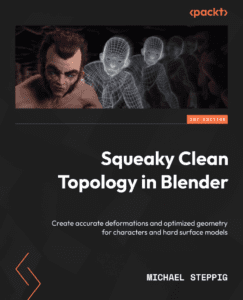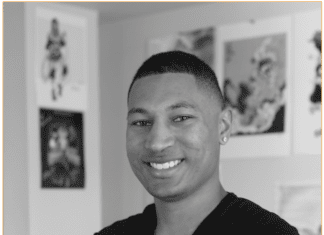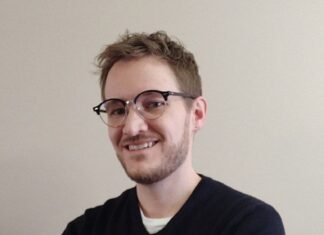Michael Steppig is the author of Squeaky Clean Topology in Blender, we got the chance to sit down with him and find out more about his experience of writing with Packt.
Q: What is/are your specialist tech area(s)?
Michael: 3D topology in Blender.
Q: How did you become an author for Packt? Tell us about your journey. What was your motivation for writing this book?
Michael: I had been looking for work as a 3D artist to do as I entered a new college semester when I found a job listing for an author to write a book on 3D topology. After applying for the job and talking to the team at Packt, it was exactly what I was looking for. Topology has always been a specific passion of mine, and I had intended to make a resource that I could point the people I tutor toward regarding topology, so it was the perfect opportunity.
Q: What kind of research did you do, and how long did you spend researching before beginning the book?
Michael: Most of the research I had done came with 9 years of experience practicing topology. In terms of specific preparation, I went through much of the manual for Blender to make sure that all of the terms used were correct.
Q: Did you face any challenges during the writing process? How did you overcome them?
Michael: Motivation was certainly the biggest challenge. The first chapters were not too difficult, but after the halfway point, they began to drag on. Even writing a few sentences became a struggle. The most helpful and motivating constant throughout the writing process was certainly the editors and supervisors at Packt. They really inspired me and pushed me to finish strong.
Q: What’s your take on the technologies discussed in the book? Where do you see these technologies heading in the future?
Michael: My journey using Blender has not been a normal one. When most people start using the software, it is because there is something they want to make. In my case, I just wanted to learn the software. I would choose specific projects that would teach me a new aspect of this massive software. I think that is what was so appealing about the software. It allows you to do almost anything in the artistic 3D space. Its future is only getting brighter. Since the 2.8 updates, blender has been closing the gap more and more with its competitors, providing a free alternative at the professional level.
Q. Why should readers choose this book over others already on the market? How would you differentiate your book from its competition?
Michael: This book takes a unique perspective on topology, breaking it down into its fundamental ideas before expanding on those ideas in practical examples. Other books tend to only apply applications without getting into the ideas behind them.
Q. What are the key takeaways you want readers to come away from the book with?
Michael: I want them to understand the main rules to follow while doing topology, and how to apply them.
Q. What advice would you give to readers learning tech? Do you have any top tips?
Michael: Be weary of any shortcuts. Make sure that you learn things in the proper order to avoid getting stuck, or relying on a crutch.
Q. Can you share any blogs, websites, and forums to help readers gain a holistic view of the tech they are learning?
Michael: OpenVFX discord is one of the best places to get your foot into the community.
Q. How would you describe your author journey with Packt? Would you recommend Packt to aspiring authors?
Michael: I think overall it was a good experience. There were some issues with the editing team as people moved in the company that caused some hiccups, but these were all overcome in a positive way. I would certainly recommend Packt to aspiring authors.
Q. Do you belong to any tech community groups?
Michael: The OpenVFX discord is the biggest community I am part of.
Q. What are your favorite tech journals? How do you keep yourself up to date on tech?
Michael: I mostly follow Blender YouTubers and chat with the people in the OpenVFX discord.
Q. How did you organize, plan, and prioritize your work and write the book?
Michael: I already had a good idea of what I wanted to talk about going into it, so the outline went rather quickly. I was given the schedule for each chapter, and simply divided the number of pages by the number of days until the chapter was due, and do that amount of pages each day. This usually came out to be around two pages a day with a few days off per week.
Q. What is the one writing tip that you found most crucial and would like to share with aspiring authors?
Michael: Write every day. Even if you can only manage a little. Keeping momentum is incredibly important.
Q. Would you like to share your social handles? If so, please share.
Michael: michaelsteppig.artstation.com
You can find Michael’s book on Amazon by following this link: Please click here









